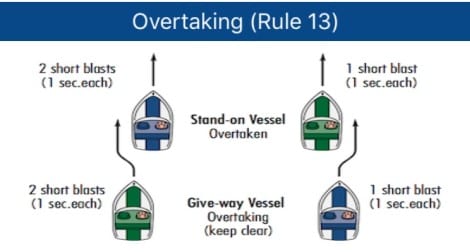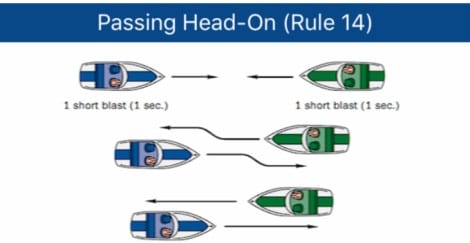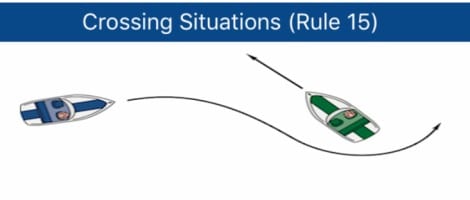 By Bob Currie, Recreational Boating Safety Specialist
By Bob Currie, Recreational Boating Safety Specialist
U. S. Coast Guard Auxiliary Base Galveston Flotilla
When most people hear the word “road” they think of the land-based definition: “A wide way leading from one place to another, especially one with a specially prepared surface for vehicles.” Mariners also think about the roads they travel on the water such as defined channels and shipping lanes. Both land and sea-based roads have rules that must be followed in order to avoid a collision.
The Base Galveston Flotilla of the US Coast Guard Auxiliary operates out of the US Coast Guard base on Galveston Island. They aid the Coast Guard by providing maritime observation patrols in Galveston Bay; by providing recreational boating vessel safety checks; and by working alongside Coast Guard members in maritime accident investigation, small boat training, providing a safety zone, Aids to Navigation verification, cooking in base and station galleys and aboard cutters; and on the Coast Guard Drone Team.
Rule 5: Post a Lookout
You must designate someone to watch for dangers that may come from any direction. You must maintain a proper lookout by sight and hearing as well as by all available means appropriate in the prevailing circumstances and conditions so as to make a full appraisal of the situation and of the risk of collision. This means that if you have working radar, it must be used as well as providing a visual lookout.
Rule 6: Safe Speed
Except where speed is restricted by regulation or the waterway is marked by a “No Wake” or “Slow Speed” aid, you must judge “safe speed” for yourself. You must take into account the following:
- Visibility
- Vessel traffic
- Your boat’s ability to maneuver
- Background lighting at night
- Draft in relation to depth of water
- Weather Conditions (including wind, sea, current and proximity to hazards)
Rule 7: Risk of Collision
Rule 7 comes into play whenever another vessel is detected, whether by sight, hearing, Automatic Identification System (AIS), or radar. Below is the wording of the rule:
(a) Every vessel shall use all available means appropriate to the prevailing circumstances and conditions to determine if risk of collision exists. If there is any doubt such risk shall be deemed to exist.
(b) Proper use shall be made of radar equipment if fitted and operational, including long-range scanning to obtain early warning of risk of collision and radar plotting or equivalent systematic observation of detected objects.
(c) Assumptions shall not be made on the basis of scanty information, especially scanty radar information.
(d) In determining if risk of collision exists the following considerations shall be among those taken into account:
(i) Such risk shall be deemed to exist if the compass bearing of an approaching vessel does not appreciably change.
(ii) Such risk may sometimes exist even when an appreciable bearing change is evident, particularly when approaching a very large vessel or a tow or when approaching a vessel at close range.
As you can see from this rule, just detecting an object is not enough; you must plot an object’s course to determine if a risk of collision exists early enough to alter course if necessary to avoid a collision.
Rule 8: Actions to Avoid a Collision
Below are excerpts from the first five sections of Rule 8:
(a) Any action taken shall be positive, made in ample time and with due regard to the observance of good seamanship.
(b) Any alteration of course and/or speed to avoid collision shall be large enough to be readily apparent to another vessel observing visually or by radar; a succession of small alterations of course and/or speed should be avoided.
(c) If there is sufficient sea room, alteration of course alone may be the most effective action to avoid a close-quarters situation provided that it is made in good time, is substantial and does not result in another close-quarters situation.
(d) Action taken to avoid collision with another vessel shall be such as to result in passing at a safe distance. The effectiveness of the action shall be carefully checked until the other vessel is finally past and clear.
(e) If necessary to avoid collision or allow more time to assess the situation, a vessel shall slacken her speed or take all way off by stopping or reversing her means of propulsion.
Changes in Course or Speed
Rule 8 says that any alteration of course and/or speed to avoid collision shall be large enough to be readily apparent to another vessel observing visually or by radar, and that a succession of small alterations of course and/or speed should be avoided. You want the other operator to know your intentions. If there is sufficient sea room, alteration of course alone may be the most effective action to a close-quarters situation provided that it is made in good time, is substantial, and does not result in another close-quarters situation. The most important thing in these cases is to be aware of all vessel traffic that could potentially cause a collision with you. That is why you must have a lookout.
Overtaking (Rule 13)
There are three important considerations when overtaking. The first consideration is to understand which vessel has the right of way. It is simple. Any vessel overtaking (passing) any other vessel shall keep out of the way of the vessel being overtaken. The nautical term for the overtaking vessel is “Give-way Vessel.” The term for the vessel being overtaken is the “Stand-on Vessel.” Both terms are self-explanatory. As the give-way vessel, you must give way (take actions necessary to avoid a collision), while as the stand-on vessel it is your job to maintain a constant speed and heading; that is, you stand on a steady course. Before changing course, you should make sure you are not being passed by another vessel. Many collisions occur when what should have been the stand-on vessel in a passing situation suddenly makes a turn either to port or starboard.
The second consideration is to signal to the other vessel your intent to overtake, and for the vessel being overtaken to signal that they understand. To pass on the port (left) side of the stand-on vessel, the give-way vessel first gives two one-second blasts of the horn, and the stand-on vessel acknowledges by giving two short blasts. Passing on the port side is the normal rule when there is enough room to do so. Sometimes the give-way vessel may desire to pass on the starboard (right side). In that case, the signal is one short blast.

The third consideration is executing the pass safely. If either boat operator feels that there is a risk of collision, then the horn signal to be given is five short, quick blasts of the horn. The pass should be executed only when it is safe to do so; that is, there is room to pass and the give-way vessel’s wake will not cause damage and proximity to the stand-on vessel does not pose a risk of collision. It’s just like passing a car on a two-lane highway.
Passing Head-On (Rule 14)
Unless otherwise agreed, when two power-driven vessels are meeting on reciprocal or nearly reciprocal courses so as to involve a risk of collision, each shall alter her course to starboard so that each shall pass on the port side of the other. In other words, keep right. Yes, it is that simple, but we saw several boats zig-zag as they approached each other, neither operator seeming to know what to do. The horn signal is one short blast. If there is any doubt about what the other vessel intends to do, the rules require you to take action to avoid a collision. In addition, sound the distress signal (5 short blasts).

Crossing Situations (Rule 15)
When two power-driven vessels are crossing so as to involve a risk of collision, the vessel which has the other on her own starboard side shall keep out of the way and shall, if the circumstances of the case admit, avoid crossing ahead of the other vessel. This is just like coming up to a 4-way stop on a highway, but there are no stop signs or yield signs. You just have to remember the rule: the vessel on your right has the right-of-way (otherwise it would be the left-of-way, right?).

Summary
If you understand that there are roads on our waterways, then you should be able to understand the Rules of the Road for those waterways. If everyone followed them, there would be far less collisions. It’s that way for our land-based roads, too. Just keep in mind that if you have a collision on a land-based road, help I just minutes away. However, if you have a collision at sea, help is at best several hours away, and only if you have the proper means for calling for help.
For more information on boating safety, please visit the Official Website of the U.S. Coast Guard’s Boating Safety Division at www.uscgboating.org. Questions about the US Coast Guard Auxiliary or our free Vessel Safety Check program may be directed to me at [email protected]. I am available to perform free Vessel Safety Checks, and I will come to your location to perform them. SAFE BOATING!
[March-22-2021]

 Posted in
Posted in 

























Excellent information!